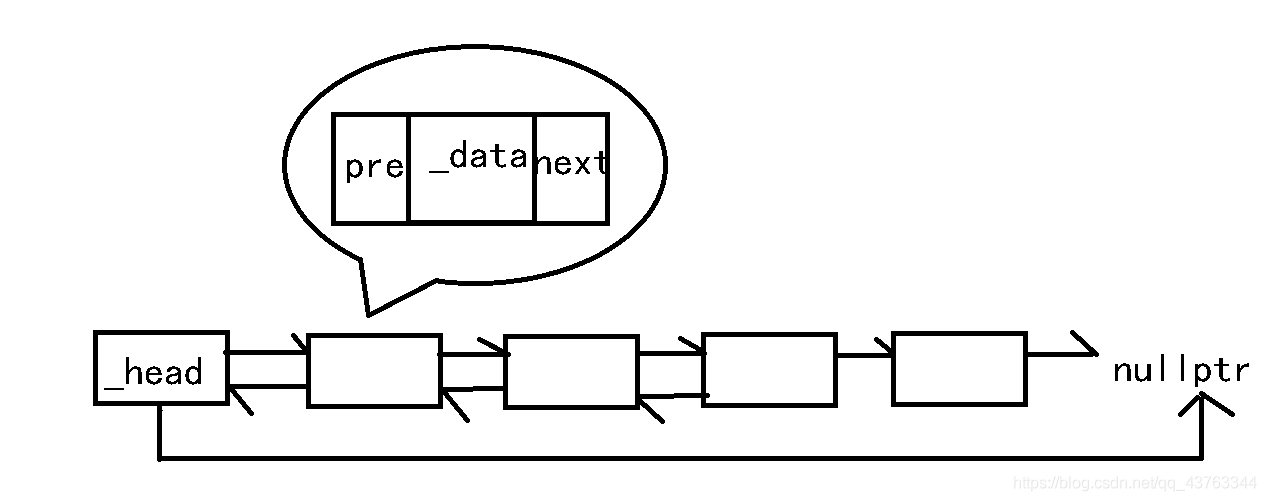双向非循环带头结点的链表

图好像有点丑~~
下列是相关操作的代码(C++ 类封装)
#pragma once
#include <iostream>
#include <stdlib.h>
#include <assert.h>
using namespace std;
//对一个结点进行封装
class Node {
public:
Node* _next;
Node* _pre;
int _data;
};
//双向非循环链表
class SList {
public:
SList(){
_head = new Node;
_head->_pre = nullptr;
_head->_next = nullptr;
_head->_data = 0;
}
~SList() {
delete _head;
_head = nullptr;
}
//尾插
void SListPushBack(int data) {
Node* node = new Node;
node->_data = data;
//只存在头结点
if (_head->_next == nullptr) {
node->_pre = _head;
node->_next = nullptr;
_head->_next = node;
}
else {
//找到最后一个结点
Node* cur = _head->_next;
while (cur->_next != nullptr) {
cur = cur->_next;
}
//进行插入
node->_next = nullptr;
node->_pre = cur;
cur->_next = node;
}
}
//尾删
void SListPopBack() {
if (_head->_next == nullptr) {
return;
}
//找到倒数第二个结点
Node* cur = _head->_next;
while (cur->_next->_next != nullptr) {
cur = cur->_next;
}
Node* node = cur->_next;
node->_pre = nullptr;
delete node;
cur->_next = nullptr;
}
//头插
void SListPushFront(int data) {
Node* node = new Node;
node->_data = data;
//如果只有头结点
if (_head->_next == nullptr) {
node->_next = nullptr;
node->_pre = _head;
_head->_next = node;
}
//至少有一个结点
node->_next = _head->_next;
node->_pre = _head;
_head->_next->_pre = node;
_head->_next = node;
}
//头删
void SListPopFront() {
if (_head->_next == nullptr) {
return;
}
if (_head->_next->_next == nullptr) {
Node* cur = _head->_next;
cur->_pre = nullptr;
delete cur;
_head->_next = nullptr;
}
//至少有两个结点
Node* node = _head->_next->_next;
Node* cur = _head->_next;
_head->_next = node;
node->_pre = _head;
cur->_next = cur->_pre = nullptr;
delete cur;
}
//在 pos 结点前面插入
void SListInsertFront(Node* pos,int data) {
Node* node;
node->_data = data;
node->_next = pos;
node->_pre = pos->_pre;
pos->_pre->_next = node;
pos->_pre = node;
}
//在 pos 结点后面插入
void SListInsertAfter(Node* pos, int data) {
Node* node;
node->_data = data;
node->_pre = pos;
node->_next = pos->_next;
pos->_next->_pre = node;
pos->_next = node;
}
//删除 pos 结点
void SListErase(Node* pos) {
//只有头结点或只剩下最后一个结点
if (pos->_next == nullptr) {
Node* pre = pos->_pre;
pre->_next = nullptr;
pos->_pre = nullptr;
delete pos;
}else{
Node* pre = pos->_pre;
pre->_next = pos->_next;
pos->_next->_pre = pre;
pos->_next = pos->_pre = nullptr;
delete pos;
}
}
//查找结点
int SListFind(int data) {
Node* node = _head->_next;
while (node != nullptr) {
if (node->_data == data) {
return 1;
}
node = node->_next;
}
return 0;
}
//删除v所对应的结点
void SListEraseV(int data) {
Node* node = _head->_next;
while (node != nullptr) {
if (node->_data == data) {
Node* next = node->_next;
SListErase(node);
node = next;
}else {
node = node->_next;
}
}
}
void Print() {
Node* node = _head->_next;
while (node != nullptr) {
cout << node->_data<<" ";
node = node->_next;
}
cout << endl;
}
private:
Node* _head;
};
在此基础上添加模板
其实变化几乎不是很大,就是把Node 改成了 Node < T >,把成员函数中出现的 内置类型,比如 :int float 都改为 T ,这个T是程序猿在实例化的时候自定义类型。
#pragma once
#include <iostream>
#include <stdlib.h>
#include <assert.h>
using namespace std;
//对一个结点进行封装
template<class T>
class Node {
public:
Node<T>* _next;
Node<T>* _pre;
int _data;
};
//双向非循环链表
template<class T>
class SList {
public:
SList(){
_head = new Node<T>;
_head->_pre = nullptr;
_head->_next = nullptr;
_head->_data = 0;
}
~SList() {
delete _head;
_head = nullptr;
}
//尾插
void SListPushBack(int data) {
Node<T>* node = new Node<T>;
node->_data = data;
//只存在头结点
if (_head->_next == nullptr) {
node->_pre = _head;
node->_next = nullptr;
_head->_next = node;
}
else {
//找到最后一个结点
Node<T>* cur = _head->_next;
while (cur->_next != nullptr) {
cur = cur->_next;
}
//进行插入
node->_next = nullptr;
node->_pre = cur;
cur->_next = node;
}
}
//尾删
void SListPopBack() {
if (_head->_next == nullptr) {
return;
}
//找到倒数第二个结点
Node<T>* cur = _head->_next;
while (cur->_next->_next != nullptr) {
cur = cur->_next;
}
Node<T>* node = cur->_next;
node->_pre = nullptr;
delete node;
cur->_next = nullptr;
}
//头插
void SListPushFront(int data) {
Node<T>* node = new Node<T>;
node->_data = data;
//如果只有头结点
if (_head->_next == nullptr) {
node->_next = nullptr;
node->_pre = _head;
_head->_next = node;
}
//至少有一个结点
node->_next = _head->_next;
node->_pre = _head;
_head->_next->_pre = node;
_head->_next = node;
}
//头删
void SListPopFront() {
if (_head->_next == nullptr) {
return;
}
if (_head->_next->_next == nullptr) {
Node<T>* cur = _head->_next;
cur->_pre = nullptr;
delete cur;
_head->_next = nullptr;
}
//至少有两个结点
Node<T>* node = _head->_next->_next;
Node<T>* cur = _head->_next;
_head->_next = node;
node->_pre = _head;
cur->_next = cur->_pre = nullptr;
delete cur;
}
//在 pos 结点前面插入
void SListInsertFront(Node<T>* pos,int data) {
Node<T>* node;
node->_data = data;
node->_next = pos;
node->_pre = pos->_pre;
pos->_pre->_next = node;
pos->_pre = node;
}
//在 pos 结点后面插入
void SListInsertAfter(Node<T>* pos, int data) {
Node<T>* node;
node->_data = data;
node->_pre = pos;
node->_next = pos->_next;
pos->_next->_pre = node;
pos->_next = node;
}
//删除 pos 结点
void SListErase(Node<T>* pos) {
//只有头结点或只剩下最后一个结点
if (pos->_next == nullptr) {
Node<T>* pre = pos->_pre;
pre->_next = nullptr;
pos->_pre = nullptr;
delete pos;
}else{
Node<T>* pre = pos->_pre;
pre->_next = pos->_next;
pos->_next->_pre = pre;
pos->_next = pos->_pre = nullptr;
delete pos;
}
}
//查找结点
T SListFind(int data) {
Node<T>* node = _head->_next;
while (node != nullptr) {
if (node->_data == data) {
return 1;
}
node = node->_next;
}
return 0;
}
//删除v所对应的结点
void SListEraseV(int data) {
Node<T>* node = _head->_next;
while (node != nullptr) {
if (node->_data == data) {
Node<T>* next = node->_next;
SListErase(node);
node = next;
}else {
node = node->_next;
}
}
}
void Print() {
Node<T>* node = _head->_next;
while (node != nullptr) {
cout << node->_data<<" ";
node = node->_next;
}
cout << endl;
}
private:
Node<T>* _head;
};





 本文介绍了如何使用C++通过类来实现双向非循环带头结点的链表,并在此基础上添加了模板功能。通过将Node改造成模板类Node<T>,并替换成员函数中的内置类型为T,允许程序员在实例化时自定义数据类型。
本文介绍了如何使用C++通过类来实现双向非循环带头结点的链表,并在此基础上添加了模板功能。通过将Node改造成模板类Node<T>,并替换成员函数中的内置类型为T,允许程序员在实例化时自定义数据类型。

















 700
700

 被折叠的 条评论
为什么被折叠?
被折叠的 条评论
为什么被折叠?










